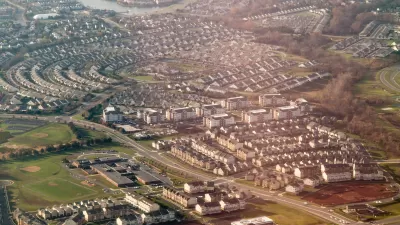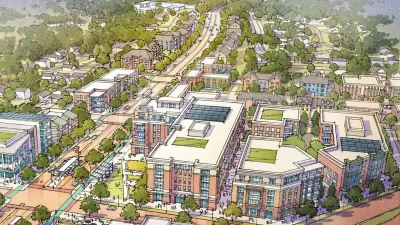The D.C. suburbs seem to be fertile ground for some of the nation's most ambitious retrofit projects. The latest plan to be made public would transform a 1950's era apartment and retail complex in Silver Spring, reports Jonathan O'Connell.
With the region emerging from the recession as perhaps the strongest economy in the nation, and recent trends in population growth projected to continue, developers and planners are bullish on the potential to transform Washington D.C.'s inner suburbs into urbane mixed-used transit-oriented communities. We've heard recently about plans afoot for Tysons Corner in northern Virginia. Now comes news about plans by developer Tower Cos. to overhaul the Blairs apartment and retail complex in Silver Spring, Maryland.
"Silver Spring, like many of Washington’s suburbs, is quickly evolving to accommodate an influx of residents and shoppers seeking neighborhoods that are walkable and accessible to public transit," writes O'Connell. "The Blairs’ massive surface parking lot and steep slope make the area difficult to navigate on foot. For a property near the Silver Spring Metro and MARC stations, as well as a revitalized downtown area, Tower officials believed that it was time for a major change."
“The Blairs has had a suburban design, and it has been that way since the 1960s,” said Ed Murn, Tower’s director of development, adding that “what we’re trying to do is transition to an urban, transit-oriented, pedestrian-friendly community.”
"Over the next 10 years, Blair Towers would be replaced by four much larger high-rise apartment buildings, ranging from 260 to 370 units each," explains O'Connell. "Tower hired Canadian architect Bing Thom, who designed the renovated Arena Stage in Southwest Washington, and Massachusetts planning and design firm Sasaki Associates."
"In all, the Blairs would go from having 1,371 apartments to 2,800. 'This is a suburb that’s becoming a city,' Thom said."
FULL STORY: Blairs complex in Silver Spring headed for major overhaul

Americans May Be Stuck — But Why?
Americans are moving a lot less than they once did, and that is a problem. While Yoni Applebaum, in his highly-publicized article Stuck, gets the reasons badly wrong, it's still important to ask: why are we moving so much less than before?

Using Old Oil and Gas Wells for Green Energy Storage
Penn State researchers have found that repurposing abandoned oil and gas wells for geothermal-assisted compressed-air energy storage can boost efficiency, reduce environmental risks, and support clean energy and job transitions.

Placekeeping: Setting a New Precedent for City Planners
How a preservation-based approach to redevelopment and urban design can prevent displacement and honor legacy communities.

San Francisco’s Muni Ridership Grew in 2024
The system saw its highest ridership since before the Covid-19 pandemic, but faces a severe budget shortage in the coming year.

Colorado Lawmakers Move to Protect BRT Funding
In the face of potential federal funding cuts, CDOT leaders reasserted their commitment to planned bus rapid transit projects.

Safe Streets Funding in Jeopardy
The Trump administration is specifically targeting bike infrastructure and other road safety projects in its funding cuts.
Urban Design for Planners 1: Software Tools
This six-course series explores essential urban design concepts using open source software and equips planners with the tools they need to participate fully in the urban design process.
Planning for Universal Design
Learn the tools for implementing Universal Design in planning regulations.
Heyer Gruel & Associates PA
City of Moreno Valley
Institute for Housing and Urban Development Studies (IHS)
City of Grandview
Harvard GSD Executive Education
Salt Lake City
NYU Wagner Graduate School of Public Service
City of Cambridge, Maryland





























